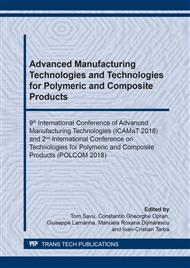p.417
p.427
p.437
p.445
p.455
p.465
p.475
p.483
p.493
The Influence of 3D Printing Parameters on Elastic and Mechanical Characteristics of Polylactide
Abstract:
The purpose of this paper is to evaluate the influence of 3D printing parameters (i.e. print speed, infill density, infill patterns) on the elastic and mechanical properties (i.e. Young modulus, yield limit, ultimate tensile strength). These properties have been determined experimentally on different specimens subjected to tensile loading using a universal testing machine INSTRON 8872. For these experimental investigations, the test specimens were manufactured in accordance to ASTM standards, modifying the following printing parameters: print speed, infill density, infill patterns. The influence of printing parameters on elastic and mechanical properties is necessary for a better understanding of the material behavior necessary in modelling and design of some type of structures manufactured using 3D printing method.
Info:
Periodical:
Pages:
483-492
Citation:
Online since:
June 2019
Authors:
Price:
Сopyright:
© 2019 Trans Tech Publications Ltd. All Rights Reserved
Share:
Citation:



